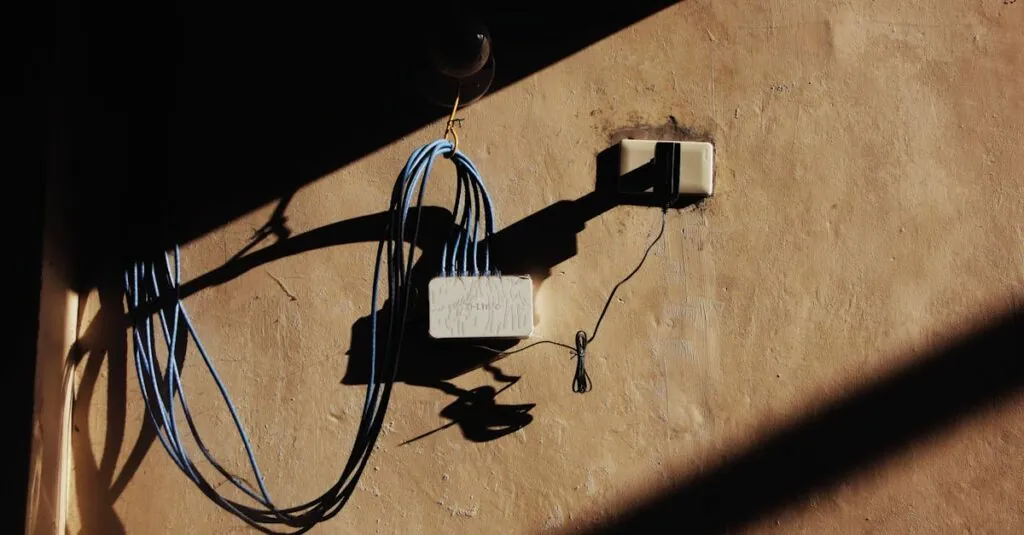Table of Contents
ToggleImagine stepping into your home and having it greet you like an old friend. With smart home systems, that dream can become a reality. These systems don’t just add a sprinkle of convenience; they transform everyday living into a tech-savvy experience that even your pet goldfish will envy.
Installing a smart home system may sound daunting, but it’s easier than finding matching socks in the dryer. From controlling lights with a simple voice command to setting the perfect temperature while lounging on the couch, the benefits are endless. Embrace the future of living and discover how smart home installation can turn your humble abode into a high-tech haven. Who knew home improvement could be this fun?
Overview Of Smart Home System Installation
Smart home system installation simplifies daily tasks and enhances comfort. Many devices integrate seamlessly with existing home networks, allowing users to control lights, thermostats, and security systems through smartphones or voice commands. Starting with a reliable Wi-Fi connection ensures optimal performance of the smart devices.
Choosing the right components is vital. Security cameras, smart locks, and lighting systems provide a solid base for a smart home framework. During installation, one should prioritize the central hub, as it coordinates communication among devices. Various hubs exist, like Amazon Alexa and Google Home, suitable for different preferences.
Wiring can be a key consideration. Hardwired devices often offer better reliability than wireless options, especially in large homes. Contractors or DIY enthusiasts may handle installation depending on the complexity. Professional services usually guarantee correct setup and functioning of each device.
Testing the system is crucial. Ensuring each gadget operates properly provides peace of mind. Users should check connectivity and response times immediately after installation. It’s also beneficial to familiarize oneself with the interface of the setup app, making adjustments easier in the future.
Maintenance plays an essential role in smart home systems. Regular updates for firmware and software help in preventing potential security issues and enhancing performance. Monitoring usage patterns allows users to customize settings further, maximizing efficiency and energy savings.
Benefits Of Smart Home Systems
Smart home systems offer numerous advantages that significantly improve daily living. Users experience enhanced convenience, increased security, and greater energy efficiency.
Enhanced Security
Smart home systems enhance security through integrated devices like security cameras, motion detectors, and smart locks. These devices provide real-time alerts and remote monitoring, allowing them to control access from anywhere. Homeowners can receive notifications on their smartphones when unusual activity occurs. Additional features, like video surveillance storage and live streaming, offer peace of mind. Automated lighting can simulate occupancy when away, deterring intruders. Collectively, these elements create a fortified environment, ensuring occupants feel safe in their homes.
Improved Energy Efficiency
Energy efficiency improves with smart home systems, which optimize daily usage by allowing users to monitor and control energy consumption. Smart thermostats adjust heating and cooling based on occupancy patterns, decreasing unnecessary energy waste. The utilization of smart bulbs also aids in reducing electricity use by enabling users to schedule lighting or dimming. Additionally, smart plugs can turn off devices not in use, further saving power. These features collectively contribute to lower utility bills and a reduced environmental impact. Adopting smart home technology fosters a more sustainable lifestyle while enhancing overall comfort.
Types Of Smart Home Systems
Smart home systems typically fall into two categories: wired systems and wireless systems. Each type offers unique advantages depending on the homeowner’s preferences and needs.
Wired Systems
Wired systems rely on physical connections like copper or fiber optic cables. These systems often provide enhanced reliability and stability, making them suitable for larger homes. Installation of wired systems requires professional assistance, as extensive cabling must be integrated into the home’s infrastructure. Users appreciate the minimal interference from outside signals in wired setups, which can lead to fewer connectivity drops. Smart lighting and security cameras work particularly well in wired environments, ensuring consistent performance.
Wireless Systems
Wireless systems utilize Wi-Fi or Bluetooth technology for connectivity. These systems offer flexibility and ease of installation, allowing homeowners to set up devices without extensive wiring. Many choose wireless systems for their ability to integrate with smartphones and voice-activated assistants. Compatibility with various devices, such as smart thermostats and plugs, adds to their appeal. Wireless systems also allow for easy relocation of devices as household needs change. The convenience of app-based control and remote access enhances the user experience while maintaining a modern aesthetic.
Steps To Install A Smart Home System
Installing a smart home system involves several key actions that ensure optimal performance and usability.
Planning Your System
Planning is fundamental to a successful installation. Begin by assessing the home’s layout and identifying areas that would benefit from smart technology. Pinpoint goals such as enhancing security or improving energy efficiency. Establish a budget, considering both devices and installation services if needed. Prioritize the components that align with specific needs, such as smart locks for security or smart thermostats for energy savings.
Choosing The Right Devices
Choosing devices requires careful consideration of compatibility and features. Research brands known for quality and reliability, ensuring they integrate seamlessly into the existing network. Select a central hub like Amazon Alexa or Google Home for easy control of the entire system. Evaluate individual devices such as cameras, motion sensors, and smart bulbs based on functionality and user reviews. Match devices with the planned use cases to enhance the home environment effectively.
Installation Process
The installation process varies based on device type and home setup. For wireless devices, follow the manufacturer’s instructions for pairing them with the central hub. Hardwired installations may require professional assistance for optimal performance. Start with the central hub, connecting it to the Wi-Fi network. Then, install additional devices, ensuring each connects smoothly for comprehensive coverage. Test each component thoroughly post-installation to confirm functionality and ease of use.
Common Challenges And Solutions
Smart home system installation presents several challenges. Connectivity issues often arise during setup. Ensuring strong Wi-Fi coverage throughout the home minimizes these problems. Weak signals result in devices failing to communicate effectively, leading to frustration.
Complexity in compatibility can also create obstacles. Not every smart device integrates seamlessly with all central hubs. Researching compatibility specifications before purchasing devices saves time and effort. Ensuring that chosen products work together streamlines the installation process significantly.
Installation methods vary, and this can complicate the setup. DIY installation works for many simple devices, but hardwired options typically require professional assistance. Individuals with basic knowledge can tackle wireless installations, while larger homes benefit from expert installation of wired devices.
Another challenge involves accurately configuring settings for each device. Users may find it difficult to navigate setup apps or adjust preferences correctly. Consulting user manuals or online tutorials provides guidance and improves the installation experience. Engaging with customer support for intricate issues often leads to effective solutions.
Lastly, regular maintenance is crucial for longevity and performance. Many users overlook necessary firmware updates, which can lead to functionality issues. Establishing a routine for monitoring system health and updating software ensures devices remain efficient and secure.
Identifying and addressing these challenges enhances the overall smart home experience. Taking proactive steps makes the installation process smoother and more enjoyable for all homeowners.
Embracing smart home technology can significantly elevate daily living. With the right installation approach homeowners can enjoy a seamless integration of devices that enhance comfort and security. Whether opting for a wired or wireless system the benefits are clear.
From convenience to energy efficiency these systems offer a modern solution to everyday challenges. By addressing potential installation hurdles and committing to regular maintenance users can ensure their smart home operates at peak performance. The journey into smart living is not just about technology; it’s about creating a more connected and efficient home environment.







